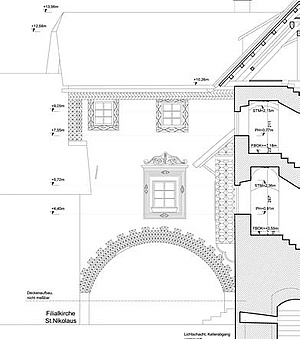
Commissioned by Austrian Federal Forests, Forest Management Unit Styria, this building research project’s goal was to survey the client’s objects in the Upper Styrian community of Großreifling, many of which are disused, in order to draw attention to, and ultimately, to revitalise that material cultural heritage. The project consists of two phases: the first one involved surveying and mapping the historical objects known as Neuer Kasten, Alter Kasten (12th and 13th century granaries and former administrative buildings), Kohlwaage (19th century industrial monument containing a weighing device), Rechenschreiberhaus (former administrative building), and the Forestry Administration, Staff and Labourers’ Dwelling House (Neuhaus); the second stage included mapping structural damage, compiling an energy performance certificate, drawing up an action plan and providing a cultural and art historical evaluation. From an epistemological perspective, the huge practical relevance of dealing with the issue of disused buildings, i.e. of social and cultural resources in rural communities, is significantly related to the partially precarious situation in many rural regions. Hence, the intention of our project will depend on the question as to which material and cultural traditions could be visualised by analysing edifices. Importantly, surveying is not only a means of mapping structural damage and preparing an emergency action plan, but also a scientific process that enables linking social and cultural resources to historical building fabric. In the first phase, façades and interiors were measured with the aid of a laser tachymeter. This method allows an accurate measurement of points up to 5mm. Resultant data was processed in the form of a digital “point cloud” which will help to provide a detailed evaluation of façade photogrammetry, façade plans, floor plans and sectional views. In that way, it is possible to achieve the greatest possible precision in the course of recording historical building fabric.
Project duration:
2013 – 2014 Financing:
Österreichische Bundesforste AG Project management:
Simone Hain
Manfred Omahna
Volker Pachauer
Alfred Rucker
Bernhard Schabbauer
Institute of Urban and Architectural History, TU Graz Project partnership:
Österreichische Bundesforste AG
ZT DI Dr.techn. Anton Reithofer
2013 – 2014 Financing:
Österreichische Bundesforste AG Project management:
Simone Hain
Manfred Omahna
Volker Pachauer
Alfred Rucker
Bernhard Schabbauer
Institute of Urban and Architectural History, TU Graz Project partnership:
Österreichische Bundesforste AG
ZT DI Dr.techn. Anton Reithofer
